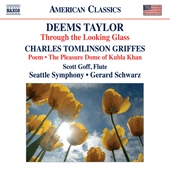
Charles Tomlinson Griffes, killed by the Spanish flu pandemic in 1920 at age 35, serves as one of the great what-ifs of American art music. Much of what he wrote is so sophisticated that here clearly are the beginnings of a remarkable composition career.
- Classical Music 101: What Does A Conductor Do? - June 17, 2019
- Classical Music 101 | What Does Period Instrument Mean? - May 6, 2019
- CLASSICAL MUSIC 101 | What Does It Mean To Be In Tune? - April 23, 2019
A recent addition to Naxos’ American Classics series by the Seattle Symphony and its former music director Gerard Schwarz offers an excellent opportunity to appreciate the imagination and technique of this talented man, who worked as a teacher in a private boys’ school by day, and composed by night.
Griffes was born in Elmira, in upstate New York, in 1884, and died of complications from a severe bout of flu on April 8, 1920, in New York City.
When he was 19, already proficient at the piano, Griffes set off for a four-year stay in Germany to study with composer Engelbert Humperdinck (of Handel and Gretel fame). His studies there put him at the centre of all sorts of musical influences at the turn of the 20th century, all of which somehow shaped his work.
Rather than follow any single school of thought, Griffes, like Charles Ives (who was 10 years older), dreamt up his own musical language based on experiments with tonality and texture. Like many artists of the day, Griffes was fascinated with Middle Eastern and Asian cultures and their ‘exotic’ sounds.
One of the other reasons to pay attention to this music today is that, besides being good, it represents a strand of composition cut short by the European horrors of the 1930s and World War II that is being picked up by tonally minded 20-something composers today.
Here is his one and only serious Piano Sonata, from 1919, followed by Two Sketches Based on Indian Themes, published after Griffes’ death, played by the Cypress String Quartet. The Sonata is played here much too ferociously by Michael Lewin (its first movement does open with the instruction, Feroce) in a 1996 Naxos recording.
(I posted a video of the Impressionist “Fountains of the Acqua Paola” from four Roman Sketches last spring, here.)
The late Edward Maisel, who wrote a biography of Griffes in 1984, considered the composer’s most sophisticated writing to also include a set of art songs from 1918, Three Poems of Fiona Macleod.
Here is “Rose of the Night,” not particularly well sung, but nicely accompanied, showing off Griffes’ complex musical language:
Here are performances by others of the better-known of Griffes’ pieces on the album, starting with The Pleasure Dome of Kubla Khan, written for piano in 1912 and orchestrated by Griffes in 1917. This is a stately performance by the Texas Festival Orchestra under conductor Michael Stern at this past summer’s Round Top Music Festival:
Here is flautist Annie Thibault, the Orchestre Symphonique de l’Isle and conductor Cristian Gort in Poem for Flute and Orchestra, written in 1919 for Georges Barrière:
And here is the original, solo piano version of “The Lake at Evening,” the first of Three Tone Pictures Griffes wrote in 1912, arranged for chamber players in 1915 and re-orchestrated for a full orchestra in 1919:
The other works on the Naxos album, are The White Peacock (1917) and Bacchanale (1913) — both of which also began life as piano pieces.
 The album also includes Through the Looking Glass by fellow American Deems Taylor (1885-1966). Although pretty in a Hollywood kind of way, it doesn’t have the distinctive character of Griffes’ work.
The album also includes Through the Looking Glass by fellow American Deems Taylor (1885-1966). Although pretty in a Hollywood kind of way, it doesn’t have the distinctive character of Griffes’ work.
Schwarz and the Seattle Symphony present the music clearly, with excellent balance and a wonderful, burnished sound in this 1990 recording originally released on the Delos label.
For all the details on the Naxos album, click here.
John Terauds
- Classical Music 101: What Does A Conductor Do? - June 17, 2019
- Classical Music 101 | What Does Period Instrument Mean? - May 6, 2019
- CLASSICAL MUSIC 101 | What Does It Mean To Be In Tune? - April 23, 2019



